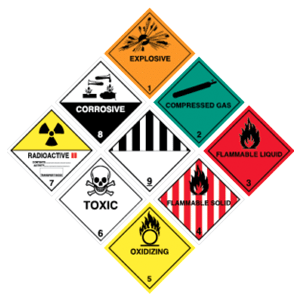Dangerous Goods Transportation
This guide will help you understand the measures required to transport dangerous goods in a safe and compliant manner.

If you transport dangerous goods by air, sea, road, rail or inland waterway, you must pack and transport them according to international regulations. In this guidance you will find relevant parts of the legislation, using categories most commonly consigned at UCL.
The Classification of Dangerous Goods
Dangerous goods are assigned to different classes depending on their predominant hazard. The UN classifies dangerous goods in the following nine classes:
| UN Class | Dangerous Goods |
|---|---|
| 1 | Explosives |
| 2 | Flammable gas, non-flammable, non-toxic gas, toxic gas |
| 3 | Flammable liquid |
| 4 | Flammable solid, spontaneously combustible substance, substance which emits flammable gas in contact with water |
| 5 | Oxidising substance, organic peroxide |
| 6 | Toxic substance, infectious substance |
| 7 | Radioactive material |
| 8 | Corrosive substances |
| 9 | Miscellaneous dangerous substances |
For further advice or if your questions cannot be answered by guidance in this website, please contact the UCL Dangerous Goods Safety Advisor. E-mail: dangerousgoods@ucl.ac.uk
- Responsibilities of Consignors or Shippers
Transport regulations refer to those preparing goods for transport as 'Consignors' or 'Shippers'.
A consignor is an individual or organisation that 'consigns' dangerous goods. Consignment means identifying hazards, packaging, marking, labelling and providing documentation ready for transportation. 'Consignor' is used in road transport regulations. The same role is described as a 'shipper' in the air transport regulations.
The Consignor/Shipper's responsibilities include the need to:
- Identify hazards
- Package materials suitably and safely
- Mark and label materials correctly
- Provide information on materials being carried to the carrier (e.g. courier company)
- Transporting Substances Between UCL Buildings
If transporting dangerous goods by hand or on a trolley between UCL buildings, transport regulations do not apply, however you should follow the general principles below:
- Containers being transported should be leak-proof (e.g. sealable plastic boxes)
- If the container is a tube, it must be tightly capped and placed in a rack to maintain it in an upright position
- Containers and racks should be placed in robust, leak-proof plastic or metal transport boxes with secure, tight-fitting covers
- Label containers/boxes appropriately with the contents
- Carry relevant identification data (such as safety data sheets) with you
- Where possible, conceal your package from public view - place in an anonymous outer package such as a shopping bag
- Never leave a package unattended at any stage
- Take the most direct route and always use pedestrian crossings if moving across public roads
NB Dangerous goods should not be transported by taxi, bus, tube or train.
For advice please contact UCL's Dangerous Goods Safety Advisor - dangerousgoods@ucl.ac.uk- Transporting Chemicals
A chemical substance may be classified into one or more of several classes according to hazard. Depending on the class and quantity of material to be transported, legislative requirements will apply to varying extents.
The principle guidance is to avoid transport unless you absolutely have to.
It is recommended to buy substances from approved suppliers and arrange delivery to a third party if necessary. If this is not possible, contact the UCL Dangerous Goods Safety Advisor in order to correctly classify the substance you wish to transport.
E-mail: dangerousgoods@ucl.ac.uk
Please provide the following information:
- Name of substance and CAS number, if you know it
- Concentration of mixture if not a pure substance (e.g. 2M, 5% v/v, 500ml in 2M)
- Quantity of substance (including units)
- Where you intend to transport from and to
- Whether you intend to transport by road or air
For further information visit our Transporting Chemicals page.
- Transporting Infectious and Biological Materials
Biological material is exempt from transport regulations if it falls into one or more of the following categories.
- Non-pathogenic, wild type micro-organisms
- Waste or biological material that has been inactivated so it no longer poses a risk of infection
- Substances transported in a form whereby any pathogens present have been neutralised or inactivated such that they no longer pose a health risk e.g. material fixed in formaldehyde
- Dried blood on absorbent material
- Environmental samples (including food and water samples) not considered to pose a significant risk of infection
- Naked nucleic acid, plasmids or liposome gene delivery systems
If the material does not fall into the exempt categories above and is Genetically Modified and/or an Infectious substance, transport regulations apply.
In order to correctly classify the substance you wish to transport, please contact the UCL Dangerous Goods Safety Advisor. E-mail: dangerousgoods@ucl.ac.uk.
For further information visit our Transporting Infectious and Biological Materials page.
- Transporting Radioactive Substances
Radioactive substances are classified based on their activity level, measured in becquerel (Bq) or Bq per gram.
A particular substance or consignment may be exempt (none of the regulations apply), excepted (some parts of regulations apply) or otherwise needs to be fully consigned.
For further information visit our Transporting Radioactive Substances page.
Last updated: Monday, July 13, 2020
 Close
Close


